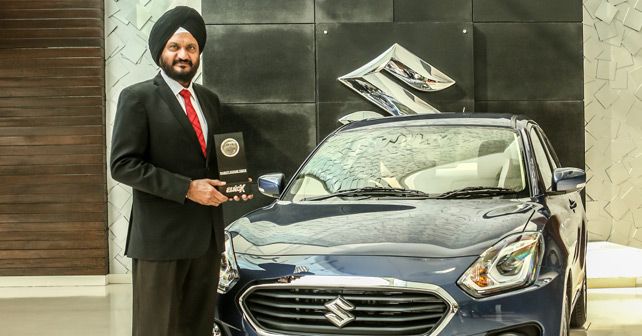
Maruti Suzuki Dzire
How has 2017 been for Maruti Suzuki?
RSK: Things are going well, particularly when people are saying the market is bad and that there’s turbulence from demonetisation and GST implementation. Through all this, as a result of strategic and tactical planning, we’ve grown at 17% so far year-on-year, while the competition is only at about 2.4% – and that speaks volumes about how we’ve anticipated these disruptions and taken counter measures.
Where do hybrids stand going forward, considering they no longer get any tax benefit?
RSK: We feel that hybrids are a step towards the direction that the government has set with regard to electric vehicles. It’s important that we start through this route – smart hybrid to strong hybrid, which will help us develop an understanding of partly electric vehicles. With that, the localisation structure will get built up and this will help in terms of cost reduction – allowing us to reach fully electric vehicles. So, from that point of view, hybrids are very important. Tax benefit or not, we are committed to bringing in superior and environmentally friendly technologies into the country.
What are your development plans for EVs?
RSK: Well, 2030 is an aggressive timeline. We feel that, by 2030, both should co-exist – liquid fuel powered vehicles and electric vehicles. As far as preparations are concerned, this has already been initiated. But it’s not just the matter of being able to make an electric vehicle. In fact, we’ve done it in the past. In 2010, we had displayed some electric vehicles at the Auto Expo. So, one point is your capability to make it, second is your capability to commercially produce it, and the third is the sustainability in terms of availability of the infrastructure to create a supporting ecosystem. These three things have to come together. Whatever deadlines are given by the government, we will comply with them – as we’ve always done in the past. One challenge is the availability of the infrastructure for charging, secondly, the cost structure is very high at present – an EV would turn out to be almost double that of a liquid fuelled vehicle. So, under these circumstances, the government has to support the industry and we have to localise very fast.
You’ve already made a step in that direction?
RSK: Yes, we’re talking about investing Rs.1,200 crores with Toshiba and Denso. By, 2020, the plant should be operational – and it’ll be a big step towards staring electric mobility in the country.
Does electrification necessarily mean EVs?
CVR: Electrification has to happen. Our point is that the Niti Aayog report says that 40% of all vehicles need to be electrified in the personal space by 2030, 100% of fleet vehicles, 100% of buses, and 100% of three wheelers. When we talk about electrification of the fleet, we’re talking about hybrids in addition to pure electric vehicles. Whenever a government or a company says that its entire fleet will be electric by such-and-such date, the small print is that it includes hybrids as well. So, what it says in the headline and what is says in the fine print is very different. But, having said that, we need to pursue these technologies. Our Chairman has already stated that we would like to be leaders in this space, but this has to be backed up by good charging infrastructure – and we don’t see anything as yet.
How big a challenge is the 2030 goal vis-à-vis the infrastructure?
CVR: Well, the infrastructure has to be built. But that’s one part of the equation. Another part is the price equation – what a car means to you and what you want in a car. The average price point that we talk about in India is about 600,000 Rupees – while an EV will be at least twice that value. So, in this case, you have a Rs.6 lakh Baleno, but an e-Baleno will be, say, Rs.13 lakhs or thereabouts. Would you buy a Baleno at Rs.13 lakhs, which comes with range anxiety, or would you buy a Ciaz or something that doesn’t have this anxiety?
Is there any change in the urgency with which you’re developing your own diesel engine – because of wariness towards diesels now?
CVR: One thing that’s very clear is that diesel volume will come down. The cost of diesels will go up. The difference today of Rs.1 lakh will go up to Rs.2 lakhs approximately. Diesel Particulate Filters, and other related after treatment technologies, will have to be added.
Has it become more challenging now to do a base model, because you have to meet a certain baseline level in terms of safety, features, styling, etc.?
RSK: Yes, that’s a challenge. But there’s no compromise on safety. When people used to talk about a car below a certain price point – our stance was always that we would never compete in that category. So, safety is always a concern and we’ve never compromised – be it a high-end model or a low-end model.
Have you seen any on-ground benefits yet from GST from the point of view of logistics?
RSK: There is a slight improvement, but the potential is much higher. At the execution level, there is some laxity as of now. The government’s dream, and even the stakeholder’s dream, is that if a truck starts from Srinagar it should be able to go right down till Kanyakumari uninterrupted. But this is not happening. The states still have to align themselves with the central government’s policies, and enforcement has to be ensured. There should be audit points at the borders to ascertain why these goods carriers are being stopped. Of course, the introduction of related initiatives – such as smart cards to pay toll – will help.


















Write your Comment